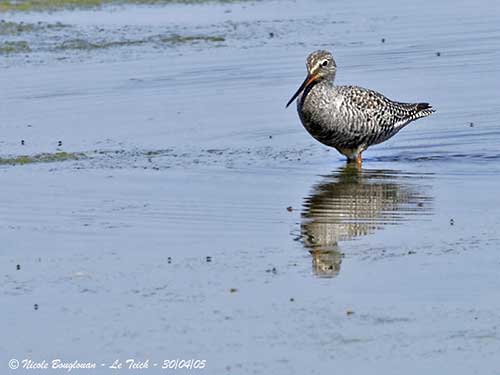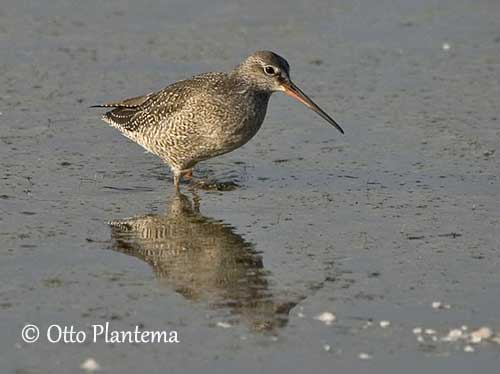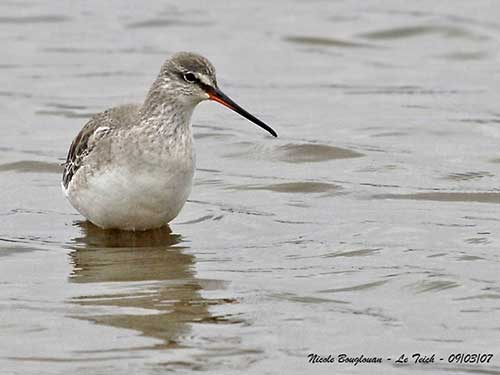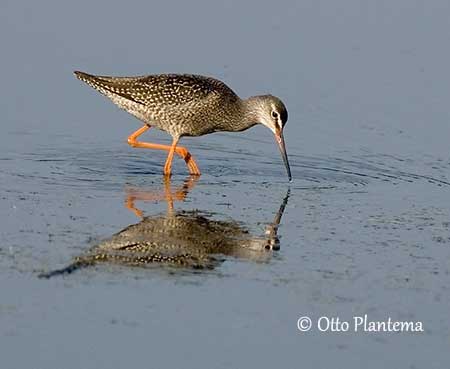
Fr: Chevalier arlequin
Ang: Spotted Redhsank
All: Dunkler Wasserläufer
Esp: Archibebe Oscuro
Ita: Totano moro
Nd: Zwarte Ruiter
Sd: svartsnäppa
Photographers:
Otto Plantema
Trips around the world
William Price
PBase-tereksandpiper & Flickr William Price
Nicole Bouglouan
Photographic ramble & My pictures on IBC
Text by Nicole Bouglouan
Sources:
HANDBOOK OF THE BIRDS OF THE WORLD Vol 3 by Josep del Hoyo-Andrew Elliott-Jordi Sargatal - Lynx Edicions - ISBN: 8487334202
THE HANDBOOK OF BIRD IDENTIFICATION FOR EUROPE AND THE WESTERN PALEARCTIC by Mark Beaman, Steve Madge - C. Helm - ISBN: 0713639601
ENCYCLOPEDIE DES OISEAUX DE FRANCE ET D’EUROPE – de Peter Hayman et Rob Hume - Flammarion – ISBN : 2082009920
THE COMPLETE BOOK OF BRITISH BIRDS – Written by “Royal Society for the Protection of Birds” experts - Préface de Magnus Magnusson - Michael Cady- Rob Hume Editors - ISBN: 0749509112
SHOREBIRDS by Peter Hayman, John Marchant and Tony Prater – Christopher Helm – 1986 – ISBN: 0747014035
GUIDE DES LIMICOLES de D. Taylor - Delachaux et Niestlé - ISBN : 2603014080
What Bird-The ultimate Bird Guide (Mitchell Waite)
Birds of Britain - The Web Magazine for Birdwatchers
Wikipedia, the free encyclopaedia
SORA Searchable Ornithological Research Archive (Blair O. Wolf)
Bird Words - The official site of Dominic Couzens, natural history writer
Birdwatch – The Home of Birding
Spotted Redshank
Tringa erythropus
Charadriiformes Order – Scolopacidae Family
INTRODUCTION:
The Spotted Redshank is a wary, noisy wader, larger and more elegant than the Common Redshank. It is often named “Sentinel of the Marshes” as it flies off while yelling a warning to other birds.
The Spotted Redshank has beautiful sooty-black breeding plumage and long, needle-like bill. It is known for its spectacular “sky dance” at the beginning of the breeding season. The females often leave the breeding grounds up to a week before the eggs hatch, or desert their mates with brood at an early stage. The males rear the young alone, and migrate with the juveniles after the nesting period.
The Spotted Redshank is migratory. It breeds in the northernmost regions of Eurasia, and moves S to spend the winter as far as equatorial Africa, India and SE Asia.
It is threatened by habitat loss in the wintering areas and on migration, but currently, the Spotted Redshank is not globally threatened.

DESCRIPTION OF THE BIRD:
Biometrics:
Length: 29-32 cm
Wingspan: 61-67 cm
Weight: 159 g (97-230 g)
The Spotted Redshank adult in breeding plumage has sooty-black head, neck and entire underparts except the undertail-coverts which are blackish and white. Some individuals may have whitish fringes on breast, flanks and belly. On the underwing, coverts and axillaries are white.
On the upperparts, the mantle is largely blackish, but scapulars, wing-coverts and tertials are blackish with white spotting and fringing. The tertials edges are conspicuously notched with white. The flight-feathers are blackish, while secondaries and inner primaries are notched and barred whitish. Back and upper rump are uniformly white, whereas lower rump and uppertail are barred white and dark grey. The tail is blackish to dark grey and narrowly barred white.
The long bill is blackish with red base of lower mandible. It is straight and slender with slight droop at tip. The eyes are dark brown with narrow, white eyelids. Legs and feet are bright red.
The female is slightly larger than male, with usually paler plumage, showing white tips to crown feathers and more white-edged feathers on the underparts.
The non-breeding adult has pale brownish-grey upperparts from forehead to mantle and scapulars (the latter with narrow fringes on the larger scapulars). Wing-coverts and tertials are spotted and notched whitish.
The white to greyish-white underparts show grey wash on breast sides and upper flanks, whereas rear flanks and undertail are finely barred.
On the head, we can see a white supercilium contrasting with the blackish lores. The cheeks are whitish.
Legs and feet are mostly orange-red and the bill has orange-red base of lower mandible.

The juvenile is darker and browner than non-breeding adult, with dense spots and notches on head, upperparts and breast. Chin and throat are whitish, and underparts are greyish and barred with brownish-grey.
RANGE:
The Spotted Redshank breeds in Scandinavia and NW Russia, through N Siberia to Chukotsky Peninsula. It winters from W Europe through Mediterranean to equatorial Africa, and E through Persian Gulf and India to SE Asia, SE China and Taiwan.
HABITAT:
The Spotted Redshank breeds in wooded tundra and also in more open areas, including heathland and shrubby tundra. It can be seen in swampy coniferous woodland or birch forest near the treeline.
Outside the breeding season and on passage, it frequents large muddy estuaries, brackish lagoons, and locally freshwater marshes and lakes, usually near the sea.

CALLS AND SONGS: SOUNDS BY XENO-CANTO
The Spotted Redshank in flight gives a sharp, rapid whistle “tu-wik” falling and rising in pitch. The alarm call is a short “chip”. Within the flocks, the contact call is “uck”. On the breeding grounds, it gives repetitive creaking or grinding “krrew-ee krrew-ee…” interspersed with typical calls and tremoulous whistles. The song is given in flight but also from perch.
BEHAVIOUR IN THE WILD:
The Spotted Redshank feeds primarily on both aquatic and terrestrial insects and their larvae, but it also takes crustaceans, molluscs, worms, small fish and amphibians.
It sometimes forms dense flocks, and the group members seem to chase prey in unison, moving while pecking or running in the same direction. This species often wades in fairly deep water (20-30 cm), but it also swims, almost upending like a duck. It sweeps the bill from side to side through water, pecks, probes and jabs. It feeds both by day and night.
During the breeding season, it performs beautiful aerial displays while giving creaking whistles. The male performs a spectacular “sky dance” with swift descents and upwards sweeps of equal speed, accompanied by a rattling motion of the wings.
They are monogamous with very short pair-bond. Some birds can be polyandrous.

The Spotted Redshank is migratory. The moult occurs in staging areas before the birds reach the wintering grounds where the species is present between October and April. The return migration to N takes place in late April/mid-May, with arrivals in Finland from the first week of May. The females move S from early June, then the male move in July, and the juveniles in August/September. Vagrants are widely recorded.
The Spotted Redshank performs a swift, direct flight. Toes and little tarsus project beyond the tip of the tail during the flight.

REPRODUCTION OF THIS SPECIES:
The laying takes place from mid-May to late June. The Spotted Redshank nests in scattered pairs with 2-3 nests/km² (maximum 15 nests).
The nest is on the ground, a shallow depression in moss and grass tussocks, sometimes against a stone or a branch. The cup is lined with grass, dead leaves, stems, pine needles and some feathers.
The female lays a single brood of 4 pale green eggs with dark markings. Both adults share the incubation during 23-24 days, starting with the last egg. At hatching, the chicks have dark grey down with fine darker markings above, dark head, and whitish chin and belly.
The male performs most of incubation and rears the chicks alone, as the female leaves up to one week before the eggs hatch. The young fledge about 28 days after hatching.

PROTECTION / THREATS / STATUS:
The Spotted Redshank is threatened by habitat loss in its wintering range and on migration, through coastal erosion and drainage of wetlands. It is also vulnerable to pollution and heavy harvesting of benthic fauna.
The global population was estimated to number 110,000/350,000 individuals in 2006, and this population is suspected to be stable.
The Spotted Redshank is currently evaluated as Least Concern.
